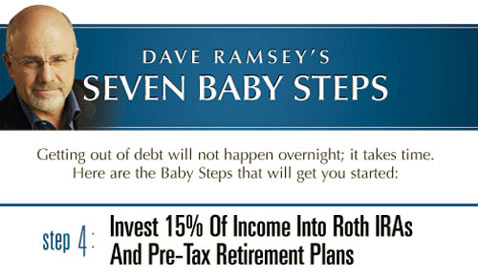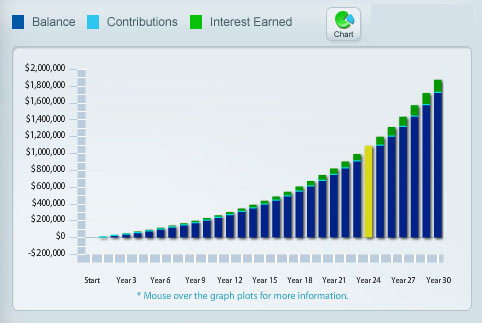Last time in the baby steps series we looked at baby step 3, saving up 3-6 months of expenses. You never know when you're going to have an unplanned expense like a major medical event or a job loss. It's best to plan ahead and be ready when those things happen, because, they will happen!
Today in baby step 4 we want to look at the things you should do once your debt is gone and you've saved up a 3-6 month emergency fund (or more like we have). It's time to invest!

Baby Step 4: Invest 15% Of Gross Income Into Roth IRAs And Pre-Tax Retirement
Baby step 4 is for me the point in the process where you realize that you've reached the top of the hill, and from now on you'll be coasting downhill saving up for retirement. It's an exciting step in my opinion. You’ve finally paid off your debts (except the house) and built up your big emergency fund, and now it’s time to save in a variety of places to fund your retirement!
Ramsey suggest saving 15% of your household income in good solid long term investments. Personally I think 15% is a good starting number – although I would love to save even more!
Why Is 15% A Good Number To Invest?
To give a graphical display of why saving 15% for your retirement is suggested by Dave Ramsey, I went and inputted some numbers into his investment calculator. I put in these numbers:
- Making $100,000 a year
- Saving 15%
- $1250/month invested (15% of 100k)
- Starting at age 30
- Saving for 30 years
- 8% return on the investments (Ramsey suggests a 10% return, I'm a bit more conservative)
When you put in those numbers above, it comes up with a return of well over 1.875 million dollars by the age of 60.
If you were to keep it going even for 5 more years until the age of 65, the account would grow to over 2.794 million dollars. That’s not half bad!

Ramsey actually suggests that you'll see returns in excess of 10% on your investments. While I don't think it's impossible, I do think that a more realistic number is around 8%. Be conservative in your planning and if your returns are more – great!
What Should I Invest In?
Now that we've decided on 15% or so to invest, we need to look at what investment vehicles we want to use. Ramsey suggests:
If you receive a company match in your 401(k), 403(b), or TSP; invest in those plans, up to the match, first. Once your contribution equals the company match, fully fund a Roth IRA for you and your spouse. If you’ve maxed out your contribution to your Roth IRA and still have money to invest, invest the rest in your 401(k), 403(b), or TSP.
So he suggests that you invest in:
- Company 401k or other plan up to the match. (free 100% return!)
- Roth IRA for you and spouse if you have one.
- Max out the 401k or other plan
In your company 401k, Roth IRA or Traditional IRA, Dave suggests allocating your investments with a good mix of mutual funds. His preferred plan is to allocate 25% to each of the following types of stocks in your funds:
- Growth
- Growth & Income
- Aggressive Growth
- International
Personally I've been a bit wary of Dave's investing advice as a lot of very smart people have suggested that his strategy of using front end loaded mutual funds means you'll be paying a ton in fees – and your returns won't be more than just investing in a good index fund, or other low cost investments. That may be an argument for another day – but I think we can all agree – that investing 15% or more is a great idea for everyone – the earlier you get started, the better.
What do you think about baby step 4 – is 15% be enough for you to save for your retirement? Do you think you should save more or less? Do you have another strategy? Tell us about it in the comments.